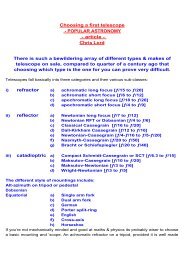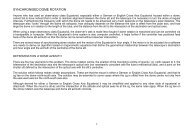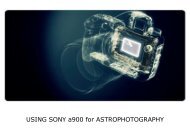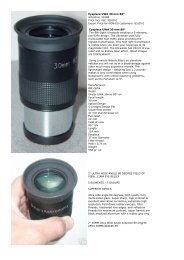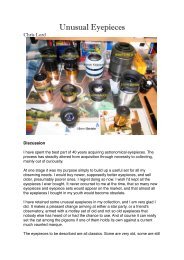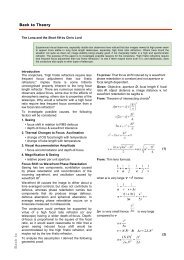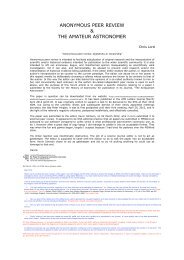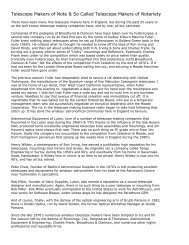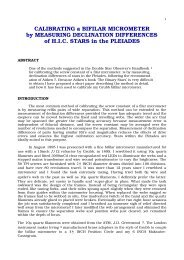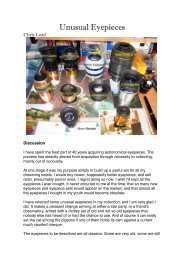Evolution of the Astronomical Eyepiece - Brayebrook Observatory
Evolution of the Astronomical Eyepiece - Brayebrook Observatory
Evolution of the Astronomical Eyepiece - Brayebrook Observatory
You also want an ePaper? Increase the reach of your titles
YUMPU automatically turns print PDFs into web optimized ePapers that Google loves.
EVOLUTION <strong>of</strong> <strong>the</strong> ASTRONOMICAL EYEPIECE<br />
DERIVATIVES OF THE PLÖSSL AND<br />
SYMMETRICAL:<br />
The first wide-angle modification <strong>of</strong> <strong>the</strong><br />
Plössl was <strong>the</strong> aplanatic eyepiece <strong>of</strong> Dr.<br />
Otto Schröder, described in Gill’s articles<br />
on telescopes in <strong>the</strong> 9th. edition <strong>of</strong><br />
<strong>the</strong> Encycl opaedia Britta nica . The<br />
glass employed is re f e r red to as<br />
Dauget’s crown (Cb1) and flint (Fb1). It<br />
comprised a pair <strong>of</strong> achromats spaced<br />
at 83% <strong>the</strong>ir ef fective focal length. The<br />
crown elements being plano-convex,<br />
plane surfaces facing <strong>the</strong> eye, and <strong>the</strong><br />
flin ts being co ncave meniscus. Eye<br />
relief was 0.54Fe, and <strong>the</strong> apparent<br />
field 72˚. Thi s design w as initi ally<br />
employed by Schönfeld in his sou<strong>the</strong><br />
rn Durchm usterung, and su bsequently<br />
marketed by Browning.<br />
ERFLÉ I - A 1-2-2 design having a 60˚<br />
field but eye relief only 0.3Fe. The<br />
glasses used were SF2, PSK3, FK5 and<br />
SF10.<br />
ERFLÉ II - A 2-1-2 design using <strong>the</strong><br />
same glass types having a 70˚ field and<br />
0.6Fe eye clearance. Paten ted after<br />
Erflé’s death in 1923.<br />
ERFLÉ III - A 1-2-2 design using <strong>the</strong><br />
same glass types having a 55˚ field and<br />
eye clearance <strong>of</strong> 0.32Fe. Patented after<br />
Erflé’s death in 1923.<br />
KAPELLA - Patented after Erf l é ’ s<br />
death in 1923 for Zeiss by Kapella, one<br />
<strong>of</strong> his assistants. A 1-2-2 design having<br />
a 70˚ field and 0.685Fe eye clearance.<br />
The glasses used were BK1, SK15 and<br />
FN11.<br />
Zeiss’ m odifi cation <strong>of</strong> t he Plö ssl,<br />
and <strong>the</strong> subse qu en t i nc orporation<br />
<strong>of</strong> <strong>the</strong> field lens to w ide n t he f ield,<br />
led Hein ri ch Erf lé to desi gn th e f irst<br />
true w ide-an gle ey epi ece f or m ili tary<br />
use in 1917 .<br />
36<br />
KASPEREIT - A modification <strong>of</strong> Erflé’s<br />
designs by Kaspereit having a 2-2-2<br />
for m, giving fields in excess <strong>of</strong> 68˚ and<br />
eye r elief 0.3Fe+. The glasses used in<br />
modern variants are SF2, BK7, SK20<br />
and SF10. Some W.W.II (World War II)<br />
variants using Thorium or Uranium<br />
glass have fields wider than 70˚.<br />
All <strong>the</strong>se Erflé types and <strong>the</strong>ir derivatives<br />
suf fer from lateral colour, astigmatism<br />
and rectilinear distortion.



